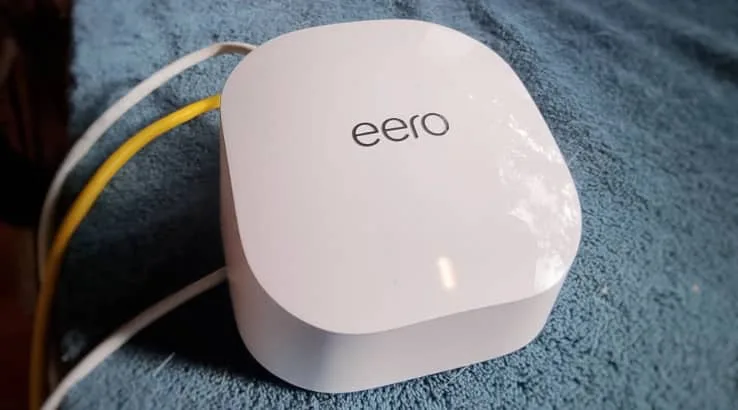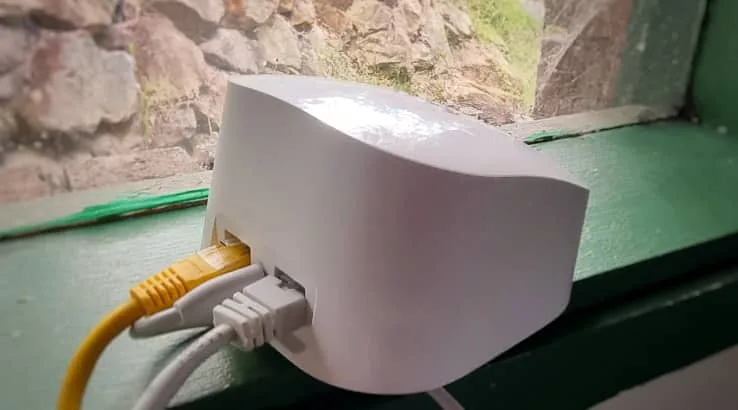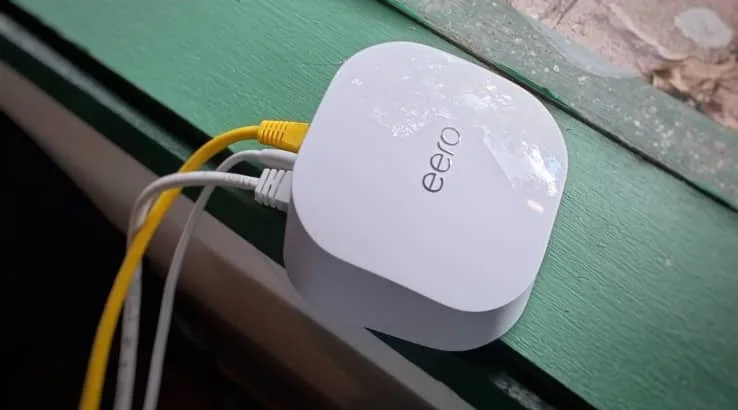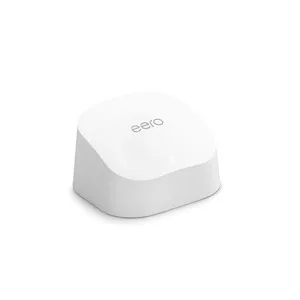Amazon eero mesh 6 review: Simple mesh with good speeds
Summary
Quick verdict: Amazon’s eero mesh 6 is beautifully simple to set up and keep running, but it’s not a system for those who want to tweak network variables.
- Very easy set-up
- NBN compatible for direct FTTP/HFC connection
- Included security options
- Embedded zigbee hub
- Not great if you want to tinker with network settings
- Can’t handle top-tier gigabit NBN if you have it
Mesh networking systems are often held up as the gold standard way to enhance your home or office's internal Wi-Fi, bringing together a set of standalone nodes to intelligently send signals far and wide in the most optimal way.
Amazon's latest eero offering adds the speed of Wi-Fi 6 to the mix, and it's an easy enough recommendation if you want the benefits of mesh networking without having much in the way of networking nous. The trade-off there is that it's a very managed solution, and not that simple to modify if you do need to tweak network settings.
Design
Design
- Low profile simple nodes
- Only the primary router node has ethernet

Mesh networking systems typically work from a simple premise of having at least one "primary" node that hooks into your home or office Internet connection that then talks to a number of additional nodes that you place around your building to enhance coverage.
Amazon's eero nodes are amongst the most plain you can buy, but that's not necessarily a condemnation of them. Does anyone particularly want flashy looking nodes in their homes? Until somebody invents a mesh node that also acts as a flower vase, probably not.
The default eero 6 kit comprises three nodes: one primary router node and two extender nodes. There's just no way that you can get them confused, because the primary router node features two ethernet ports for connecting up your modem, while the extender nodes are ethernet-free.
That's not terribly surprising at this price point, but it does mean that they're slightly less flexible for small offices where having an ethernet jack on each node can be quite useful.
Installation
Installation
- App based install couldn't be simpler
- Quick install process
- Can work directly with FTTP/HFC NBN
- No browser support

Just about every single mesh networking system on the market today works from an app-led process, because it's the easiest way for everyday consumers to wrap their heads around network configuration.
I've got to hand it to the Amazon eero team though, because even though it's basically a standard, the eero app (iOS/Android) makes it amazingly simple to get up and running with the eero 6 system.
Set up an eero account, and walk through the set-up for the router node first of all, before adding in any additional extender nodes. The process is well explained and pairing was fast, even in areas of my test set-up that usually encounter problems.
Where I've hit issues in the past with slow firmware updates or twitchy mesh acceptance of far-away nodes, I had no such issues at all with the Amazon eero mesh 6.
If you're using an NBN connection based on FTTP or HFC, you don't even need an external ISP supplied modem, because the eero mesh 6 will happily accept an incoming ethernet connection from your NBN device on those connection types. However, you may need to get your ISP to kick out your existing connection so it can match up properly, and some ISPs may prefer you to keep their gear in the loop for support calls.
Amazon promises that the eero app offers "frustration-free" set-up, and for most consumers that will be absolutely true. There is a subset that might find the eero mesh 6 a tad frustrating, and that's anyone who would prefer to use a web browser based set-up. It's simply not supported, and if you try to access the network via the primary router's IP address on your local network, it'll tell you to get the apps to control eero mesh. Or in other words, go away, but politely.
Performance
Performance
- Wi-Fi 6 capable
- Good throughput speeds
- Good signal propagation
- Acts as a zigbee hub for smart homes
- Can't quite manage full speed NBN
- Difficult to change network configuration

The Amazon eero mesh 6 is a Wi-Fi 6 ( 802.11ax/ac/n/g/b if you want to get technical about it) system operating on dual band 2.4Ghz/5Ghz, although in typical operation you won't see two distinct networks. Indeed, once it's all set up all you should see is gloriously available Wi-Fi throughout your home or office. Or at least, that's the promise of the eero mesh 6, same as any other mesh system.
One slight catch here for a smaller proportion of the Australian audience on FTTP NBN, and an even tinier slice of HFC, is that the top throughput of the eero mesh 6 tops out at 500Mbps, half that of a full NBN Home Ultrafast connection.
You'll probably not see the full 1Gbps out of your NBN connection a great deal, but if you're spending up big to get it, the eero Mesh 6 will leave you wanting. Amazon does have a variant of the eero mesh 6 that can handle gigabit speeds, the eero mesh 6 pro, but it doesn't sell it here in Australia.
Still, 500Mbps is a nice healthy Internet speed, so to put that to the test, I set up the eero mesh 6 in the same location as every mesh network system we've tested to date here at Finder. That's my suburban Sydney home, a moderately large 4 bedroom house with a wide enough floorplan to test out most mesh systems.
The other reason I use it for wireless testing is because my home office sits in an extension to the original property. That extension includes the original external brick wall between the office and the rest of the house, and it's the most effective way to kill Wi-Fi signal short of a power cut I've ever experienced. Lesser routers and mesh gear makes sobbing noises if I try to bring them near it, or maybe that's just my imagination.
In any case, it makes for a great test environment, because it represents the exact kind of extreme that drives many to want mesh networking gear in the first place.
To test the eero mesh 6, I tested for both signal throughput and actual download capacity across three locations.
My near spot sits essentially next to the master router node, plugged into an NBN HFC 250 connection hooked up through Aussie Broadband. The mid-range spot sits in a bedroom a couple of rooms away, while my far spot is my home office, where ordinary Wi-Fi signals fear to tread.
The first test involves measuring basic RSSI (Received Signal Strength Indicator), using an Apple MacBook Pro M1.
Here what I'm looking for are lower numbers to show signal propagation across the network. Here's how the Amazon eero mesh 6 compared:
The eero mesh 6's RSSI figures are promising, even though it's only a dual-band system, lacking a third band to manage actual throughput. Where that can have more of an effect is in actual data speeds, and let's face it, this is why you're looking to buy a mesh system in the first place.
To test data speeds, I used Finder's Speed Test on the same connection and in the same locations. To get a baseline figure, I first connected via ethernet to the primary node to assess current line connection speeds. That's important, because these can vary, but what I want to test for is speed drop over distance, especially in the worst location for testing, my home office.
Finder's Speed Test was run a dozen times in each location to get an average for download, upload and ping. Because our mesh tests cover a range of NBN speeds (and older Telstra HFC speeds), I've converted to a percentage of the available line speed, rather than absolute figures. Here's how the eero mesh 6 compared:
For just a dual band system at this price range, the eero mesh 6 acquits itself fairly well, although there are stronger systems out there in terms of sharing your broadband connection around. I also found, mostly by carefully watching my network's connection status, that the eero mesh 6 often dropped me down to 2.4Ghz even when 5Ghz should have been available, like when I was quite close to nodes – with a subsequent speed drop at that time. That's in the nature of dual band systems that have to carry their own network traffic on the standard 2.4/5Ghz bands that also carry regular traffic, but it can lead to slower speeds from time to time.
Simple mesh isn't the only trick in the eero mesh 6's arsenal either. If you have Alexa-enabled speakers such as the Echo Show 10 or basic Echo 2020 you can use Amazon's assistant to directly interface with your eero mesh system. This has added flexibility because the eero mesh router is itself a Zigbee hub for compatible smart home networking gear.
Amazon also adds a managed subscription security layer to the eero experience if you'd rather offset that set of functions to a third party. Basic eero secure ($4.99 a month) gives you ad blocking, content filtering and reporting functions, while eero Secure+ ($15.99) includes subscriptions to 1Password, Encrypt.me and Malwarebytes as well.
All of this plays well to the eero mesh 6's intended crowd, which is folks who want to set up something that'll just work and mostly manage itself. You quickly get used to the messages you get from the eero system, including when it has run firmware updates on itself, typically overnight.
However, managed also means that it's not a terribly flexible system if you do want to manage specific network functions or assignments. If you've got eero secure running at all, for example, you can't even change the default router IP address, a pretty common need for those with existing fixed IP devices. Again, you may not care, because the market for that kind of mesh network configuration isn't likely to converge much with eero's very stated managed approach.
Should you buy the Amazon eero mesh 6?
- Buy it if you want a really easy to set up mesh experience.
- Don't buy it if you need precise configuration or speeds above 500Mbps.
Networking doesn't have to be the sole province of geeky types who obsess over port forwarding and IP address ranges. Amazon's eero mesh systems are very much sold as consumer-friendly options, and while they're not the fastest out there if pure speed matters to you, it's hard to fault their position and delivery when it comes to making it very easy indeed to set up a home mesh network with decent speeds.
If that's you, then the eero mesh 6 system is a good choice at a fair price, although like most mesh systems it's a fairly hefty investment that's only worth pursuing if you already have Wi-Fi specific woes.
Pricing and availability
Price
The Amazon eero 6 system retails in Australia as a unit with one router and two extender nodes for $499. Individual extender nodes sell for $199, while standalone router nodes cost $229.Where to buy
Specifications
Images: Alex Kidman
More Finder reviews
- Apple HomePod 2nd Gen review: Yes, it’s better
- Creality Ender-3 S1 Pro Review: Plenty of creative potential, but you’ll need patience too
- Apple Mac Mini M2 Pro review: A tale of two computers
- Apple MacBook Pro M2 Max 16-inch review: Next-level power
- HTC Vive XR Elite: Is this the perfect mix of Flow and Pro?
